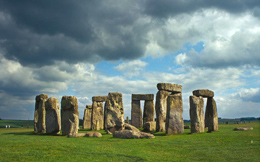
Stonehenge is probably older than previously thought
 |
Seventeen upright stone blocks, the heaviest weighing up to 45 tons, connected by six lintels, are oriented towards the sunrise on the day of the summer solstice. Among the most popular theories about the purpose of the structure are those that designate Stonehenge either as a prehistoric observatory or as a temple dedicated to the sun. Recently, a theory has emerged that disabled people visited the site, believing that the stones had healing powers.
Stonehenge continues to attract people today. During this year's summer solstice celebration, around 30,000 people gathered there. Approximately 850,000 tourists visit this monument annually. In 1986, this stone circle in the southern English county of Wiltshire was inscribed on the UNESCO World Heritage List. The construction consists of stone monoliths standing three to six meters high.
The English translation is powered by AI tool. Switch to Czech to view the original text source.
2 comments
add comment
Subject
Author
Date
Kruhové stavby
Miroslav Provod
02.12.08 08:57
záhady
Vích
02.12.08 09:22
show all comments
Related articles
0
14.09.2021 | The conservationists have started the largest repair of Stonehenge in decades
0
03.08.2018 | In the mystery-shrouded Stonehenge, even foreigners were buried
0
11.09.2014 | Stonehenge was surrounded by 17 other shrines, archaeologists found
0
10.03.2013 | Stonehenge, according to scientists, began as a cemetery for influential families
0
22.07.2010 | A further circular monument was discovered at Stonehenge
0
06.10.2009 | New discovery at Stonehenge strengthens the version of an ancient burial site










